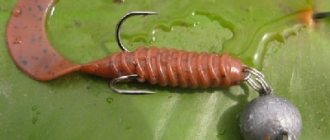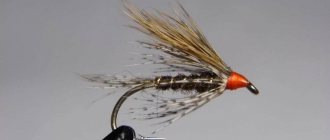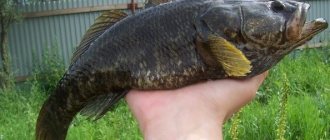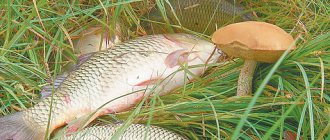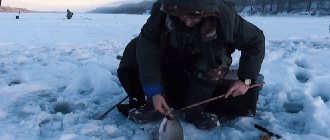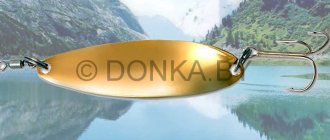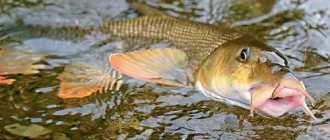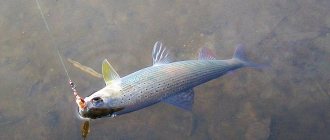Fly fishing
Another type of gear that has become very popular lately. The difference between regular spinning fishing and fly fishing is that with the first, the fisherman imitates the movement of fish in the water, and with fly fishing, some kind of fly, bug, or other insect is imitated on the surface of the water. Fly fishermen do not like to be called spinning anglers, which is why I singled out this type of fishing as a separate item. Now let's move on to more exotic methods...
Fishing in muddy water
If the reservoir is fishy, you can raise silt from the bottom, which will make the hunter invisible to the fish and at the same time force him to look for its clean water. When it rises to the surface, you can jam it with a stick, catch it with a container or bare hands, or use other methods (Figure 10).
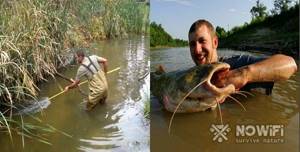
Figure 10. Fishing in troubled waters
Jar
There is no need to laugh, although at first I myself couldn’t help but smile. I have a pond near my house in the park. The lake is so-so, there is bluefish, small crucian carp, perch, in general, it’s just the right size for a cat to catch for lunch. In general, my friend and I are sitting, trying to catch at least some small fish on a huge hook, but to no avail. And then our attention was attracted by a man sitting ten meters away and holding in his hands a piece of nylon cord, which was lowered into the water.
It's a strange picture, to be honest. However, when the man lifted the cord, at the end of which was tied the simplest three-liter jar, in which our grandmothers were accustomed to roll tomatoes and cucumbers, we were completely at a loss. As a result, our catch with two fishing rods and the freshest worms amounted to three small perch. “The banker,” as we jokingly called our new friend, went home with a whole bucket of fish, and among the catch there were some very good palm-sized carp.
In fact, everything turned out to be very simple. A well-soaked piece of bread is placed at the bottom of the jar (you need to achieve such a consistency that the bread crumb will sink in water). The jar is tied by the neck with a rope and lowered into the water. The fry, followed by larger fish, swim into the jar to feast on the bait. All that remains for the fisherman to do is to lift the jar, drain the water and take out the catch. Of course, you won’t catch big fish this way, but it’s just right for pet food and for fun.
Saboteur
This tackle received this name due to the fact that it has practically nothing to do with the fisherman. People come up with various versions of such gear (balabaika, lantern, kite, etc.), however, the principle of their operation is the same - the fisherman ties a fishing line with a hook and sinker to a large floating “something” and lets it float freely. When it is necessary to check whether there is a result, the fisherman uses a boat or swims to the gear. Such fishing methods are almost always used when hunting predators.
Feeders
A feeder fishing rod also belongs to bottom gear. The name comes from the English word “feed” - “to feed”.
The peculiarity of feeder fishing is the use of special bait placed in a feeder (in the form of a cage). During the first few casts, the contents of the feeder crumble and form a spot of bait.
And here’s what you need to know: Catching sterlet on a donk: features and nuances of fishing
The density of the mixture that attracts fish depends on the strength of the current, that is, with a strong current, the bait should be more viscous, for this you can add earth and clay to it. All subsequent bait casts are made to the same place where the attracted fish bite more actively.
Using this type of fishing you can fish for carp, crucian carp, silver bream, bream and other fish that feed on the bottom.
Fishing with feeder tackle
Needed for catching non-predatory fish. Structurally very similar to the donks described above, the difference lies in the frequency of casting. This should be done every five minutes, regardless of whether there is a bite. Externally they are similar to spinning models, but have their own classification according to class, length, and action.
This tackle has the following features:
- Selection by test. Depends on the weight of the feeder - from 60 to 200 g.
- The length of the rod varies from 3.3 to 4.6 m;
- The coils used are inertialess.
The recommended spool volume of the latter is from 3000 to 6000. Installation of the cord or fishing line can be carried out in one of three ways - symmetrical, asymmetrical, inline or Gardner loop. The type of fish feeder is open, of various shapes. Recommended manufacturing material is plastic. In the latter case, you definitely need a weight.
Kwok
Nothing would force me to talk about this method if not for one detail. A professional Quaker is a very rare person, and it is difficult to learn. Fishing using the kwok method is used when hunting catfish. It is very difficult to lift this fish from the bottom. She loves great depths, and if the bite occurs at a depth of 10 meters or more, you will face a long struggle. A kwok is a wooden or metal stick with a foam or other polymer ball at the end. When such a device hits the water, it makes a croaking sound, to which the catfish rises, thinking that it is a frog.
From the other end of the boat, a hook with bait is lowered into the water to a depth of no more than a meter. The catfish, eager for the sound, grabs the bait. In this option, it is very easy to pull out fish from a meter depth. However, you still need to learn how to make such sounds; for many anglers this is a whole art. They say that the correct “kwok” can be felt even by the fifth point, because rhythmic tapping creates sound vibrations, which cause the boat to vibrate slightly.
Zakidushki and jigs
These gears are simple and functional. A traditional throw consists of a reel. A fishing line with a diameter of up to 0.9 mm is wound on it. An elastic band is attached to the weight,
Fishing Features:
- when a bite occurs, the fishing line moves, so a small bell is most often hung up as a warning;
- you need a stand to fix the reel;
- You can cast to depth from the shore or on a boat.
And here's what you need to know: Where can you go fishing for free in the Moscow region?
The disadvantage of this gear is the high probability of tearing when pulled out. The solution is to attach an additional harness to the weight.
Spearfishing
Have you ever been on a hunt? Here, it's the same thing, only in water. A special gun, a wetsuit, a mask with a snorkel, fins - this is the equipment of a real underwater hunter. For fun, you can dive into the water and shoot crucian carp and perches, but real connoisseurs of underwater hunting do not waste time on such trifles, and in their trophies they see only pike, carp, pike perch, silver carp or other fish that reach large sizes. Some even say, “Shooting a roach while spearfishing is the same as bringing home a sparrow from a regular hunt!”
Veil, spider
This tackle received such interesting names among the people, and this was the first fishing method that I tried on myself. Imagine a huge square net, one side of which reaches 3-4 meters. This net is mounted on a structure similar to a spider with four legs and a huge tail (yoke). The fisherman lowers all this gear to the bottom, waits a few minutes and with a sharp movement lifts the mesh screen above the surface of the water.
All the fish swimming past at that moment will not go anywhere. You feel special pleasure when you just lift the screen and at that moment you watch the twitching of the grid. Based on the strength of the jerks, you can deduce whether there is something inside. Often, for greater efficiency, various baits are thrown inside the net.
Rubber
Another interesting tackle. Sometimes it is also called donka, but among ordinary people, gum is a more recognizable name. This tackle consists of an impressively sized sinker to which a fishing line is attached. A piece of rubber cord is inserted between the line and sinker; it must be strong and elastic. Leashes with hooks (usually 5-7 pieces) are attached to the fishing line that is closer to the reel (on which all the tackle is wound).
The fisherman casts the sinker so that the hooks are at a fairly decent distance in the water, makes a stretch, fixes the reel on the shore, and judges whether the fish is biting by the vibration of the stretched fishing line near the reel. The method is very interesting, practically you have 5-7 float rods in one hand. You can often land several fish at once, and that's all the fun.
So, in short, we went over the main methods of fishing. You just have to choose to your taste, although I am sure that each piece of gear will bring you a lot of positive experiences. There are, of course, many other ways, but I decided to leave the other authors at least a little something to talk about, not just me alone. And in the next conversations I will tell you about the ancient methods of catching predatory fish, I will teach you how to use a balabaika correctly and where is the best place to place the stavushi.
(Visited 363 times, 2 visits today)
Equipment for catching predatory fish
- Lightweight float rod for catching live bait.
- Canna for storing live bait.
- A spool of thick fishing line 0.5mm, large single hooks, sinkers of any type.
- Kukan for storing caught fish.
- Landing net, yawner and extractor for fishing and releasing fish from the hook.
Catching predators
Pike
When fishing with a pop-up wobbler, step-by-step wiring is used. First, the wobbler is sent in a steep arc to the bottom, and after a few seconds the reel is stopped so that it begins to float - this is repeated until they pass through a deep water section.
Stepped fishing is no less effective when fishing with a vibrotail. It is very important to cast in such a way that the bait rises from the bottom of the deep area into shallow water, where it should be led above the bottom, making additional jerks with the rod.
It is best to fish with a rotating spoon near algae or snags, launching it along the border of a difficult place and clear water. A twister connected to a spinner improves the game somewhat. Moreover, the choice of spinner or twister is not decisive. The pike takes the larger “spinner”.
Oscillating spoons are most often used to catch fish in areas with strong currents. The cast can be made at right angles to the shore, then the spoon is allowed to move freely with the current. From time to time they jerk it up from the depths, avoiding snags, and reel it in.
There is one feature: in cloudy weather, bait can be cast in any direction, and in sunny weather, so that the sun is on the side. A pike caught on the bait suddenly rushes to the side, so you need to tame its burrows in a timely manner, otherwise it may lead the tackle into snags or grass.
Zander
The behavior of pike perch differs from the behavior of other predators mainly in that during daylight it always stays at depth, and with the onset of darkness it goes ashore to hunt. Pike perch has a narrow pharynx structure, so any fish with a narrow, slanted body is ideal food for it. The wobbler must also have an appropriate design, otherwise the pike perch may remain indifferent to it. The best wiring with a wobbler is horizontal, uniform or with slight accelerations.
Fishing with a heavy Kastmaster spinner is good in fast sections of rivers. The wiring in this case is fast and uniform.
Pike perch are caught with twisters and vibrotails with less effect. Of the soft baits, the most catchy one is considered to be a foam fish, which is caught using the method of step-by-step retrieval.
It is good to fish with spinners during the period when pike perch is actively moving in a flock in search of food. At this time, it can feed in different layers of water. Usually these are places saturated with oxygen, where there are a lot of fry. The spinner rig should be light enough, and the spinning rod should have the appropriate characteristics for long-distance casting of such bait.
Perch
Catching perch with a twister gives good results. All types of retrieves are suitable for this, but there are times when the fish goes all the way to the shore for a uniformly moving bait and does not take it - then a slight disruption in the rhythm of the retrieve can lead to success. The mass of the twister is selected depending on the strength of the current. In very strong currents, the use of this bait is ineffective.
Small rotating spoons of yellow or white color in combination with a red, yellow or black twister are very attractive for perch. Another good bait for perch can be fly spoons.
Sometimes the hunting location of a perch can be determined by schools of fry: jumping out of the water, they scatter in all directions.
Ide
It takes well on a perch lure. The smallest rotating petal with a tee No. 7–8 is quite suitable, since the ide has a small mouth. The French spinner Aglia-1, small spinners from Mepps, and domestic spinners and spinners are also suitable. It has been noticed that with sunrise, ide prefers dull, copper, sometimes even black spoons and spinners that have a brownish-pockmarked coloring with a red triangular plumage, and at dusk or in dim lighting - shiny baits. Combining a spinner with a vibrating tail or artificial fly often produces better results.
It is necessary to properly balance the load of the spinners. Excessive weight is of no use: it does not allow the spoon to play correctly and contributes to greater clinging to the bottom and algae. On rotating spoons, two types of sinkers are used and sometimes both at the same time: a head sinker and a sinker on a rod.
Chub
To catch this fish, first of all, the smallest rotating spoon of the Aglia-0 type is used. Casting is done in the feeding areas of the chub - it often reveals itself by hunting for fry at the border of fast and slow water. The bait is placed near the surface or in the water column, sometimes with slight jerks.
A hybrid of a rotating blade with a twister or streamer often brings success. It is very important for the fisherman to understand what color bait the chub likes in a given body of water. For example, during the period when the May beetle emerges, brown or brown baits with black specks are effective. The chub is cautious, often staying near overgrown, poorly accessible shores, so it often has to be caught by stealth, using a pendulum or catapult cast.
From the oscillating spinners, choose small, oblong-shaped ones, equipped with two small tees in the middle and in the tail, of different, but not bright colors.
For chub fishing, the best rod is at least 3 m long with a soft tip that can respond well to sudden jerks of the fish when fishing.
